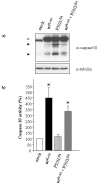Co-inherited mutations of Fas and caspase-10 in development of the autoimmune lymphoproliferative syndrome
- PMID: 17999750
- PMCID: PMC2211507
- DOI: 10.1186/1471-2172-8-28
Co-inherited mutations of Fas and caspase-10 in development of the autoimmune lymphoproliferative syndrome
Abstract
Background: Autoimmune lymphoproliferative syndrome (ALPS) is a rare inherited disorder characterized by defective function of Fas, autoimmune manifestations that predominantly involve blood cells, polyclonal accumulation of lymphocytes in the spleen and lymph nodes with lymphoadenomegaly and/or splenomegaly, and expansion of TCRalphabeta+ CD4/CD8 double-negative (DN) T cells in the peripheral blood. Most frequently, it is due to Fas gene mutations, causing ALPS type Ia (ALPS-Ia). However, other mutations, namely of the FasL gene (ALPS-Ib) and the caspase-10 gene (ALPS-II) are occasionally detected, whereas some patients do not present any known mutations (ALPS-III). Recently, mutations of the NRAS gene have been suggested to cause ALPS-IV.
Results: This work reports two patients that are combined heterozygous for single nucleotide substitutions in the Fas and caspase-10 genes. The first patient carried a splice site defect suppressing allele expression in the Fas gene and the P501L substitution in caspase-10. The second had a mutation causing a premature stop codon (Q47X) in the Fas gene and the Y446C substitution in caspase-10. Fas expression was reduced and caspase-10 activity was decreased in both patients. In both patients, the mutations were inherited from distinct healthy parents.
Conclusion: These data strongly suggest that co-transmission of these mutation was responsible for ALPS.
Figures



Similar articles
-
Identification of new Fas mutations in a patient with autoimmune lymphoproliferative syndrome (ALPS) and eosinophilia.Blood Cells Mol Dis. 1999 Jun-Aug;25(3-4):227-38. doi: 10.1006/bcmd.1999.0248. Blood Cells Mol Dis. 1999. PMID: 10575548
-
Autoimmune lymphoproliferative syndrome due to somatic FAS mutation (ALPS-sFAS) combined with a germline caspase-10 (CASP10) variation.Immunobiology. 2016 Jan;221(1):40-7. doi: 10.1016/j.imbio.2015.08.004. Epub 2015 Aug 17. Immunobiology. 2016. PMID: 26323380
-
Clincal, immunologic, and genetic features of an autoimmune lymphoproliferative syndrome associated with abnormal lymphocyte apoptosis.Blood. 1997 Feb 15;89(4):1341-8. Blood. 1997. PMID: 9028957
-
Autoimmune lymphoproliferative syndrome, a disorder of apoptosis.Curr Opin Pediatr. 1999 Dec;11(6):521-7. doi: 10.1097/00008480-199912000-00009. Curr Opin Pediatr. 1999. PMID: 10590910 Review.
-
A genetic disorder of lymphocyte apoptosis involving the fas pathway: the autoimmune lymphoproliferative syndrome.Curr Allergy Asthma Rep. 2001 Nov;1(6):534-40. doi: 10.1007/s11882-001-0062-y. Curr Allergy Asthma Rep. 2001. PMID: 11895618 Review.
Cited by
-
The genetic landscape of the FAS pathway deficiencies.Biomed J. 2021 Aug;44(4):388-399. doi: 10.1016/j.bj.2021.06.005. Epub 2021 Jun 24. Biomed J. 2021. PMID: 34171534 Free PMC article. Review.
-
Acute myeloid leukemia developing in patients with autoimmune diseases.Haematologica. 2012 Jun;97(6):805-17. doi: 10.3324/haematol.2011.056283. Epub 2011 Dec 16. Haematologica. 2012. PMID: 22180424 Free PMC article. Review.
-
Genes and Microbiota Interaction in Monogenic Autoimmune Disorders.Biomedicines. 2023 Apr 8;11(4):1127. doi: 10.3390/biomedicines11041127. Biomedicines. 2023. PMID: 37189745 Free PMC article. Review.
-
Genetic defects of apoptosis and primary immunodeficiency.Immunol Allergy Clin North Am. 2008 May;28(2):329-51, ix. doi: 10.1016/j.iac.2008.01.002. Immunol Allergy Clin North Am. 2008. PMID: 18424336 Free PMC article. Review.
-
Incomplete penetrance in primary immunodeficiency: a skeleton in the closet.Hum Genet. 2020 Jun;139(6-7):745-757. doi: 10.1007/s00439-020-02131-9. Epub 2020 Feb 17. Hum Genet. 2020. PMID: 32067110 Free PMC article. Review.
References
-
- Straus SE, Sneller M, Lenardo MJ, Puck JM, Strober W. inherited disorder of lymphocyte apoptosis: the autoimmune lymphoproliferative syndrome. Ann Int Med. 1999;130:591–601. - PubMed
-
- Straus SE, Jaffe ES, Puck JM, Dale JK, Elkon KB, Rosen-Wolff A, Peters AMJ, Sneller M, Hallahan CW, Wang J, Fischer RE, Jackson CM, Lyn AY, Baumler ES, Marx A, Vaishnaw AK, Grodzicky T, Fleisher TA, Lenardo MJ. The development of lymphomas in families with autoimmune lymphoproliferative syndrome with germline Fas mutations and defective lymphocyte apoptosis. Blood. 2001;98:194–200. doi: 10.1182/blood.V98.1.194. - DOI - PubMed
Publication types
MeSH terms
Substances
Grants and funding
LinkOut - more resources
Full Text Sources
Medical
Research Materials
Miscellaneous

